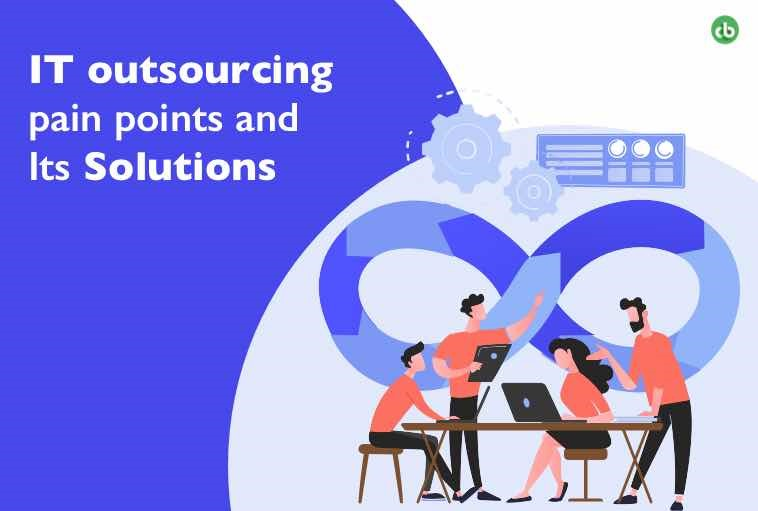admin / May 17, 2021

“I was always nervous about the communication channel due to the 9-hour time-zone difference between us”
“I had spent a huge amount of time, efforts and money in doing and undoing things due to lack of inexperienced developers”
“The final deliverables received was not worth value for money”
“I paid them the amount but they never finished the job on-time as described”
These are just a few complaints that we might have often heard about the remote teams with regards to outsourcing. Though outsourcing talents may come along with innumerable benefits including access to a wider talent pool, reduces labor cost, and improved productivity, but in reality, things aren’t as smooth as it seems. Apart from the rewards, outsourcing from the leading software development company can also involve some risks and uncertainty that can turn your million-dollar app idea into a painful and never-ending application.
But, does that mean delegating a task to the in-house team members is the only viable and cost-effective solution?
NO! While it is not feasible to eliminate all the risks involved with outsourcing projects, you can foresee and mitigate the majority of them.
As per the latest reports, IT outsourcing is expected to increase globally post COVID-19. Availability of top-class experts, advanced internet-powered communication tools, lower development cost, and constant innovation in software development are some of the key decision-making factors that are evolving IT outsourcing at a larger scale.
This blog focuses on some common pain points associated with IT outsourcing and how they can be addressed so that they can fit your expectation.
Starting an outsourcing relationship model is a challenge unless you get an idea about the things that you are going to deal with daily. Check out the following risks associated when you partner with an overseas outsourcing software development company along with solutions to turn this collaboration into a success.
When you choose to outsource your project, the thought that constantly strikes your mind is: “I need to be there in the office and gauge them face-to-face before I seal the deal” – And that’s how entrepreneurs often express their fear regarding outsourcing.
But the reality is that almost 50% of the employees would be working off-site as remote developers by the year 2020.
Developing trust takes time, especially when your team is entirely out of your eye contact. However, there are ways to get better acquainted with your future team. Let’s find out how.
To find the right candidates, you need to have in-depth information about them. Ask them questions about the company’s culture and workplace. You can even visit the country and the office of your development team in-person in case if you’re planning for long-term co-operation.
You can even check about the company’s credibility on popular platforms like Good Firms and Clutch who publishes extensive client reviews and feedbacks about multiple service providers.
You can check their case studies and portfolio for better references. You can even contact their past clients to get proper information about their services.
Communication can make or break the deal. So, if you’re receiving slower responses or one-word answers, it’s a huge RED flag for you. To succeed with your project, you need to hire a proactive team capable of understanding your idea to offer innovative and ground-breaking solutions.
To know your developers better, interview them. Ask them all the questions that you have in terms of technology, working methods, and tools. Receiving clear and prompt feedback via modes like email, phone or messengers will enhance your relationship.
Even though you’ve hired the most efficient and trustworthy development team on-board, proper team management and supervision are essential for delivering tasks on time. And here, we face the major challenge: How to keep a track of remote employees especially when you have few business hours overlapping?
To complete the project as per the estimated time, below are few ways to cope up with the risk and accomplish work.
Some entrepreneurs would prefer to control their remote team members by themselves. In that case, they can hire an on-site project manager who is aware of your hired developers and can monitor the task during local business hours. They have a huge role to play in your project success since they manage multiple things like develop work schedules and track deliverables, turn your ideas into a detailed plan, keep a check on updates, and gives you reports on time.
The sign of a good service provider is that they are quite flexible in terms of working hours and adaptability. For eg: If your client enjoys the weekend of Friday-Saturday, the PM will take a note of that and be available on Sundays.
Modern project management tools make all the vendor site activity clear and transparent. The right set of applications like Skype, Slack, JIRA, Trello, Mingle, and more can resolve your problems to a great extent. You can keep a track of the completed task and can gauge what’s still in progress along with its due date and time.
Though your project manager will keep everything in the loop, you can schedule an online meeting bi-weekly with your team members which will help you to review your goal, fix the bottlenecks, and thus create a mutual understanding in peers.
Though you have hired skilled and experienced team members in your team, sometimes they fail to deliver the expected quality. To get the best results, you should clearly define your quality standards so that they can develop the product and guarantee implementation.
You can get your quality issues in line by practicing the below tips:
To get the best results, specify your quality standards clearly in the document. The contract should mention terms regarding final product criteria that must meet the given requirements, coding parameters, structure and quality standards, maximum throughput capacity, device specification for application, and so on.
Sometimes there can be instances where the app functions properly in 2-3 attempts but later malfunctions in a week or two where the service provider is no longer accountable to resolve issues. To avoid such blunders, specify the warranty period where the development team agrees to fix all bugs at no hidden cost.
One of the best options to evaluate an outsourcing software development company’s capability is to build an MVP version of your product with essential features. Generally, MVP development takes around 2-4 weeks where you’ll figure out whether the team meets your requirements – how they resolve bugs, make updates, solve time zone issues, communicate with you, and most importantly whether they’re technically sound or not.
What about the hidden charges and Intellectual property concerns?
Sometimes, outsourcing may lead to many sudden and hidden expenses which you might have never thought of. To cope up with that, you can follow below tips:
The majority of the risks mentioned in this article are associated with cases when you’re outsourcing your project first time to any remote team/agency. But as an old saying goes: “Time fixes everything”. Finding a service provider that befits your expectations, terms and workflow are not as easy as it seems – All these take good time. The clearer and more diligent you’re at the initial stage, the more aches and pain you’ll prevent later. Considering the long view, you should invest time in building a long-lasting relationship with your vendor so that you can trust them for your go-to development needs.
So, looking to partner with an outsourcing software development company for your next project?
If yes, you’ve landed at the perfect address. Being a leading outsourcing software development company for a decade, we know what it takes to deliver an out-of-the-box solution that yields more traffic, boosts the sales funnel, and improves customer satisfaction rate. Let’s get in touch to discuss this in detail.




